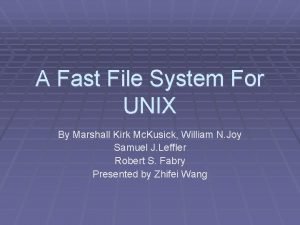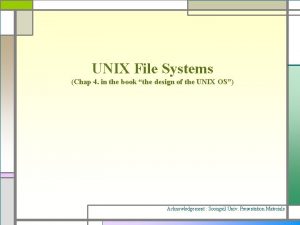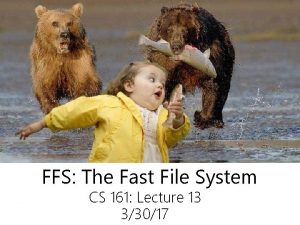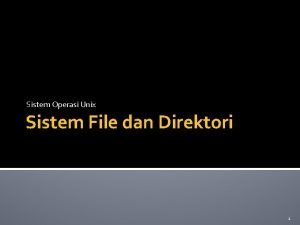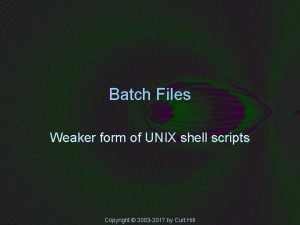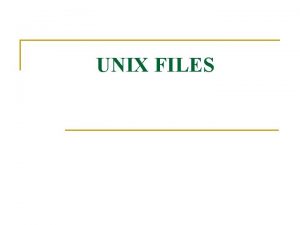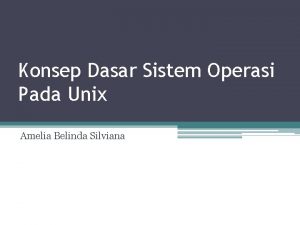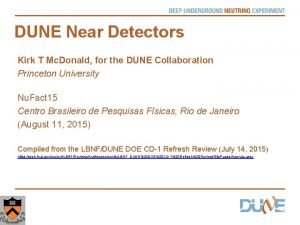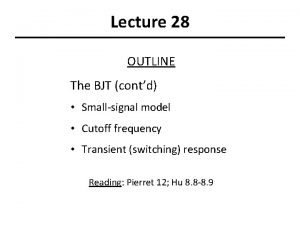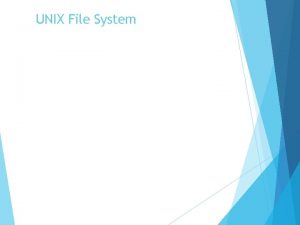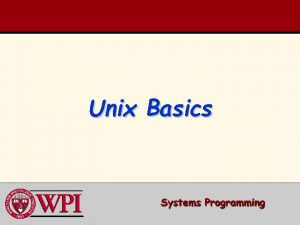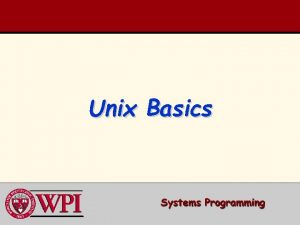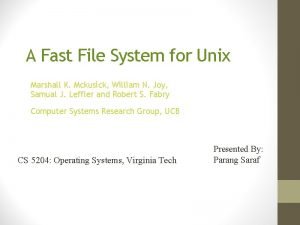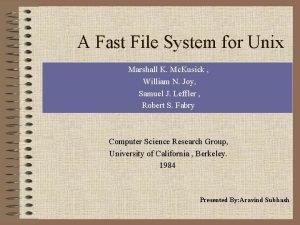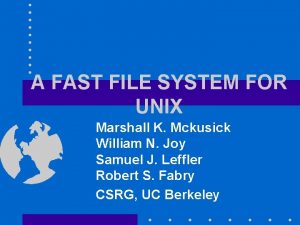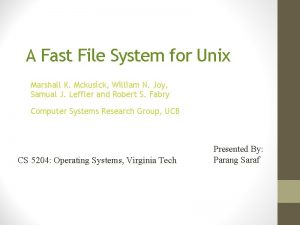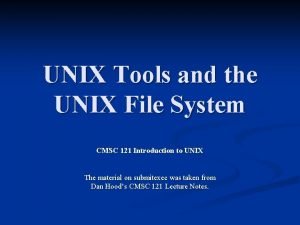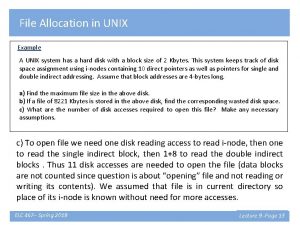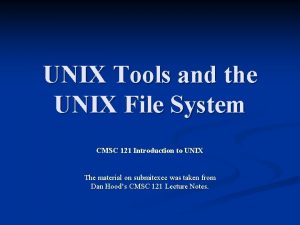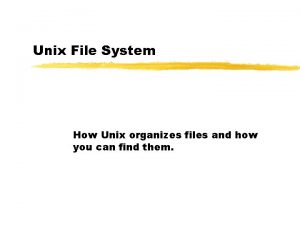A Fast File System for UNIX Marshall Kirk






























- Slides: 30

A Fast File System for UNIX Marshall Kirk Mc. Kusick, William N. Joy, Samuel J. Leffler and Robert S. Fabry University of California, Berkeley Presented by Catherine Vilhauer CS 533 - Concepts of Operating Systems 1

Introduction q Problems in old UNIX file system o Low data throughput rates not sufficient • • q E. g. VLSI design and image processing - little processing on large amount of data Old UNIX provided only 2% of the maximum disk bandwidth or 20 kilobytes per second per arm. Berkeley carried out modifications which are basis of today’s UNIX NFS CS 533 - Concepts of Operating Systems 2

Review of Disk Structure * Taken from Modern Operating Systems, Tanenbaum CS 533 - Concepts of Operating Systems 3

Limits to Disk Bandwidth q Seeking and settling time q Rotational delay o q Disk controller may be reading data into its cache Reading/writing time. CS 533 - Concepts of Operating Systems 4

Review of Disk Structure * Taken from www. storagereview. com CS 533 - Concepts of Operating Systems 5

The Old Unix File System q q Each disk drive divided into one or more partitions Each disk partition may contain one file system File system never spans multiple partitions File system described by superblock which contains basic parameters of the file system o o o q Data blocks Count of the maximum number of files Pointer to the free list Partitions set up by Master Boot Record CS 533 - Concepts of Operating Systems 6

Old UNIX File System (cont’d) q q Within file system are files (obviously) Some are directories o q Contain pointers to files that may also be directories Every file has a descriptor called an i-node o o Ownership of file Time stamps marking last modification and access times Array of indices that point to data blocks for the file May contain references to indirect blocks containing further data block indices CS 533 - Concepts of Operating Systems 7

Review of What I-Nodes Are CS 533 - Concepts of Operating Systems 8

Disk Layout in the Old UNIX File System CS 533 - Concepts of Operating Systems 9

Disk Layout in the Old UNIX File System q Problems o o o Segregation of i-node info from data Long seek time Files in a single directory not normally allocated consecutive blocks - many non-consecutive blocks of i-nodes accessed when executing operations on the i-nodes of several files in a directory CS 533 - Concepts of Operating Systems 10

Problem with old file system i-node data More data CS 533 - Concepts of Operating Systems 11

Other problems q q q Never transfers more than 512 bytes Often finds that the next sequential data block is not on the same cylinder, forcing seeks between 512 byte transfers Small block size, limited read-ahead in the system and many seeks severely limits file system throughput CS 533 - Concepts of Operating Systems 12

Initial Improvements Made at Berkeley q Basic block size increased to 1024 bytes o q BUT o q Improved performance by more than 2 x Still only using 4% of disk bandwidth Why? o o Free list (initially ordered) became scrambled after use Forced a seek every block access CS 533 - Concepts of Operating Systems 13

New File System q q Cylinder Groups added Max block size - 4096 bytes o o q Now possible to create files up to 232 bytes Size can be any power of 2 up to 4096 bytes Size is stored in super-block Allows file systems with different block sizes on same system New allocation algorithms to improve locality CS 533 - Concepts of Operating Systems 14

Cylinder Groups q Disk partition divided into Cylinder Groups o q One or more consecutive cylinders on a disk Cylinder group book-keeping info o o Redundant copy of super-block kept at varying offset so it spirals through the disk Space for i-nodes Bit map describing available blocks (replaces free list) Summary info describing usage of data blocks Begins at varying offset (so that all super-blocks not lost) CS 533 - Concepts of Operating Systems 15

Fragments and Fragmentation q q q New file system uses 4096 byte block size Allows 4 x more information to be transferred per disk transaction Problem: Small Files o q Uniformly large block wastes space Solution: Fragments o o o Can divide single file system block into one or more fragments 2, 4 or 8 fragments specified at file system creation Lower bound 512 bytes - disk sector size CS 533 - Concepts of Operating Systems 16

Fragment Example CS 533 - Concepts of Operating Systems 17

Space Allocation q q Space allocated when program does write system call Each time the system checks to see if the size of the file has increased CS 533 - Concepts of Operating Systems 18

Space Allocation - Three Types q q There is enough space - easy No fragmented blocks and no space in last block o o o q If space in already allocated block then written here Otherwise a full block is allocated and written here Process repeated until < full block of new data remains. File contains one or more fragments with no space o o If size of new data plus size of data already in fragments is greater than size of a full block, then a new block allocated and contents of the fragment are copied. Then continues as in second bullet point CS 533 - Concepts of Operating Systems 19

Space Allocation (cont’d) q Problems o o q Results o o q Data copied many times as a fragmented block expands But fragment reallocation can be minimized if the user program writes a full block at a time, except for a partial block at the end of the file. Wasted space the same as old file system Savings in space utilization offset by need to keep track of free blocks Notes o File system should not be completely full - around 90% full is optimal CS 533 - Concepts of Operating Systems 20

File System Parameterization q New file system tries to parameterize the hardware for optimum configuration o o Allocate new blocks on same cylinder as previous block Cylinder group summary info keeps count of available blocks in cylinder group at different rotational positions • • o 8 rotational positions Super-block contains vector of lists called rotational layout tables Parameter that defines the number of milliseconds between completion of a data transfer and the initiation of another data transfer on same cylinder can be changed at any time CS 533 - Concepts of Operating Systems 21

Layout Policies q Global Policies o o o q Local Policies o q Use locally optimal scheme to lay out data blocks Aims: o o q Make placement decisions for new i-nodes and data blocks Calculate rotationally optimal block layouts Decide when to force long seek because insufficient blocks Increase locality of reference to minimize seek latency Improve layout of data to make larger transfers possible Too much localization = local cylinder group run out of space CS 533 - Concepts of Operating Systems 22

Layout Policies (cont’d) q q Attempts to place all i-nodes of files in directory in the same cylinder group Directories are different o q New directory placed in cylinder group that has greater than average free i-nodes, and smallest number of directors Data blocks o o o Policy tries to place all data blocks for a file in cylinder group at rotationally optimal positions But, large files will use up all space Redirect block allocation to different cylinder group when file size >48 kilobytes and every megabyte after CS 533 - Concepts of Operating Systems 23

Layout Policies (cont’d. ) q q Global policy routines call local allocation routines If requested block not available o o Use next available, rotationally closest block If no blocks open on same cylinder, use block in same cylinder group If cylinder group full, quadratically hash to choose another cylinder group Exhaustive search CS 533 - Concepts of Operating Systems 24

New Data Layout i-node data more data CS 533 - Concepts of Operating Systems 25

Performance CS 533 - Concepts of Operating Systems 26

Performance q q Running ‘list directory’ on a large directory, number of disk accesses for i-nodes cut by factor of 2 Containing only files - cut by factor of 8 Transfer rates no longer change over time Bandwidth o o q Old file system uses only 3 -5% of disk bandwidth New file system uses up to 47% Reads and writes faster o o Due to larger block size in new file system Writes same speed as reads in contrast to old system CS 533 - Concepts of Operating Systems 27

Other new features q q q Allowed long file names - 512 bytes Implemented file locking Symbolic links o q Rename o o q References across physical file systems and inter-machine linkage Old system required 3 system calls New implementation to avoid losing file with only temporary name if system crashes Quotas o Restricts the file system resources a user can obtain CS 533 - Concepts of Operating Systems 28

Conclusion q q FFS is the basis for UFS (Unix File System) Nearly all UNIX machines use a variant of UFS including o o Solaris Unix BSD, Free Unix Mac OS offers UFS as an alternative to its HFS Linux offers partial support for UFS CS 533 - Concepts of Operating Systems 29

References q q Andrew S. Tanenbaum, Modern Operating Systems Entry on Unix File Systems in Wikipedia. org CS 533 - Concepts of Operating Systems 30
 Fast file system
Fast file system File-file yang dibuat oleh user pada jenis file di linux
File-file yang dibuat oleh user pada jenis file di linux Iget algorithm in unix
Iget algorithm in unix Fast file system
Fast file system Remote file access in distributed file system
Remote file access in distributed file system In a file-oriented information system, a transaction file
In a file-oriented information system, a transaction file Unix file name
Unix file name Unix
Unix Fifo file api in unix
Fifo file api in unix Pada unix, file dibagi menjadi 3 kategori utama
Pada unix, file dibagi menjadi 3 kategori utama Unix file apis
Unix file apis Acid fast vs non acid fast
Acid fast vs non acid fast Example of acid-fast bacteria
Example of acid-fast bacteria Physical image vs logical image
Physical image vs logical image Fungsi dari create file pada operasi-operasi file (cont.)
Fungsi dari create file pada operasi-operasi file (cont.) What does a markup tag tells the web browser
What does a markup tag tells the web browser Tronc coeliaque netter
Tronc coeliaque netter Kirk lodge approved premises
Kirk lodge approved premises Williamson medical center pharmacy residency
Williamson medical center pharmacy residency Kirk burroughs
Kirk burroughs Kirk y bateman (1962/73)
Kirk y bateman (1962/73) Kirk borne twitter
Kirk borne twitter Kirk mcdonald physics
Kirk mcdonald physics Adam kirk
Adam kirk Paul kirk forensics
Paul kirk forensics Kirk lovric
Kirk lovric Kirk t. mcdonald
Kirk t. mcdonald Ocd vicious flower formulation
Ocd vicious flower formulation Small signal model
Small signal model Jf.kirk
Jf.kirk Oxymetolazone
Oxymetolazone
